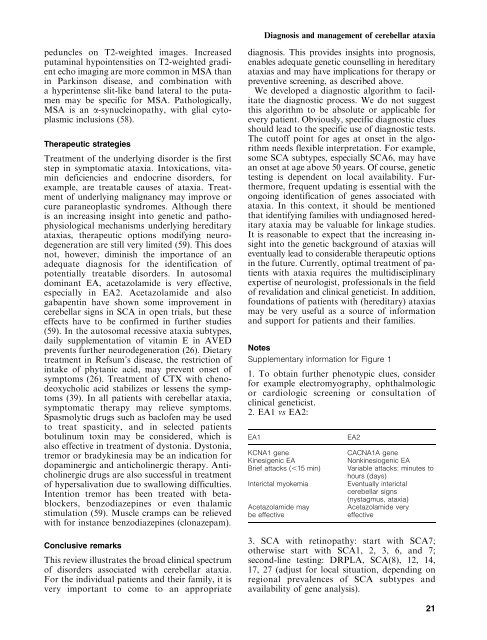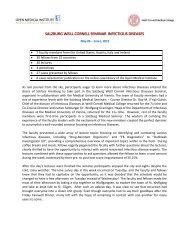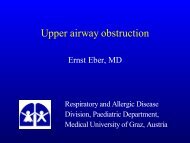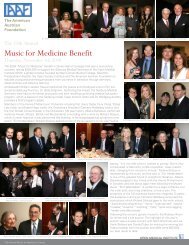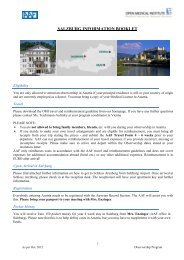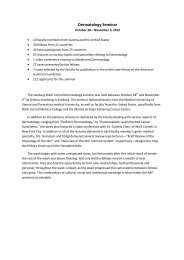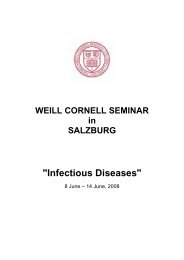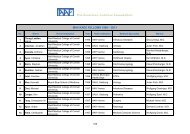Diagnosis and management of early- and late-onset cerebellar ataxia
Diagnosis and management of early- and late-onset cerebellar ataxia
Diagnosis and management of early- and late-onset cerebellar ataxia
Create successful ePaper yourself
Turn your PDF publications into a flip-book with our unique Google optimized e-Paper software.
peduncles on T2-weighted images. Increased<br />
putaminal hypointensities on T2-weighted gradient<br />
echo imaging are more common in MSA than<br />
in Parkinson disease, <strong>and</strong> combination with<br />
a hyperintense slit-like b<strong>and</strong> <strong>late</strong>ral to the putamen<br />
may be specific for MSA. Pathologically,<br />
MSA is an a-synucleinopathy, with glial cytoplasmic<br />
inclusions (58).<br />
Therapeutic strategies<br />
Treatment <strong>of</strong> the underlying disorder is the first<br />
step in symptomatic <strong>ataxia</strong>. Intoxications, vitamin<br />
deficiencies <strong>and</strong> endocrine disorders, for<br />
example, are treatable causes <strong>of</strong> <strong>ataxia</strong>. Treatment<br />
<strong>of</strong> underlying malignancy may improve or<br />
cure paraneoplastic syndromes. Although there<br />
is an increasing insight into genetic <strong>and</strong> pathophysiological<br />
mechanisms underlying hereditary<br />
<strong>ataxia</strong>s, therapeutic options modifying neurodegeneration<br />
are still very limited (59). This does<br />
not, however, diminish the importance <strong>of</strong> an<br />
adequate diagnosis for the identification <strong>of</strong><br />
potentially treatable disorders. In autosomal<br />
dominant EA, acetazolamide is very effective,<br />
especially in EA2. Acetazolamide <strong>and</strong> also<br />
gabapentin have shown some improvement in<br />
<strong>cerebellar</strong> signs in SCA in open trials, but these<br />
effects have to be confirmed in further studies<br />
(59). In the autosomal recessive <strong>ataxia</strong> subtypes,<br />
daily supplementation <strong>of</strong> vitamin E in AVED<br />
prevents further neurodegeneration (26). Dietary<br />
treatment in Refsum’s disease, the restriction <strong>of</strong><br />
intake <strong>of</strong> phytanic acid, may prevent <strong>onset</strong> <strong>of</strong><br />
symptoms (26). Treatment <strong>of</strong> CTX with chenodeoxycholic<br />
acid stabilizes or lessens the symptoms<br />
(39). In all patients with <strong>cerebellar</strong> <strong>ataxia</strong>,<br />
symptomatic therapy may relieve symptoms.<br />
Spasmolytic drugs such as bacl<strong>of</strong>en may be used<br />
to treat spasticity, <strong>and</strong> in selected patients<br />
botulinum toxin may be considered, which is<br />
also effective in treatment <strong>of</strong> dystonia. Dystonia,<br />
tremor or bradykinesia may be an indication for<br />
dopaminergic <strong>and</strong> anticholinergic therapy. Anticholinergic<br />
drugs are also successful in treatment<br />
<strong>of</strong> hypersalivation due to swallowing difficulties.<br />
Intention tremor has been treated with betablockers,<br />
benzodiazepines or even thalamic<br />
stimulation (59). Muscle cramps can be relieved<br />
with for instance benzodiazepines (clonazepam).<br />
Conclusive remarks<br />
This review illustrates the broad clinical spectrum<br />
<strong>of</strong> disorders associated with <strong>cerebellar</strong> <strong>ataxia</strong>.<br />
For the individual patients <strong>and</strong> their family, it is<br />
very important to come to an appropriate<br />
<strong>Diagnosis</strong> <strong>and</strong> <strong>management</strong> <strong>of</strong> <strong>cerebellar</strong> <strong>ataxia</strong><br />
diagnosis. This provides insights into prognosis,<br />
enables adequate genetic counselling in hereditary<br />
<strong>ataxia</strong>s <strong>and</strong> may have implications for therapy or<br />
preventive screening, as described above.<br />
We developed a diagnostic algorithm to facilitate<br />
the diagnostic process. We do not suggest<br />
this algorithm to be absolute or applicable for<br />
every patient. Obviously, specific diagnostic clues<br />
should lead to the specific use <strong>of</strong> diagnostic tests.<br />
The cut<strong>of</strong>f point for ages at <strong>onset</strong> in the algorithm<br />
needs flexible interpretation. For example,<br />
some SCA subtypes, especially SCA6, may have<br />
an <strong>onset</strong> at age above 50 years. Of course, genetic<br />
testing is dependent on local availability. Furthermore,<br />
frequent updating is essential with the<br />
ongoing identification <strong>of</strong> genes associated with<br />
<strong>ataxia</strong>. In this context, it should be mentioned<br />
that identifying families with undiagnosed hereditary<br />
<strong>ataxia</strong> may be valuable for linkage studies.<br />
It is reasonable to expect that the increasing insight<br />
into the genetic background <strong>of</strong> <strong>ataxia</strong>s will<br />
eventually lead to considerable therapeutic options<br />
in the future. Currently, optimal treatment <strong>of</strong> patients<br />
with <strong>ataxia</strong> requires the multidisciplinary<br />
expertise <strong>of</strong> neurologist, pr<strong>of</strong>essionals in the field<br />
<strong>of</strong> revalidation <strong>and</strong> clinical geneticist. In addition,<br />
foundations <strong>of</strong> patients with (hereditary) <strong>ataxia</strong>s<br />
may be very useful as a source <strong>of</strong> information<br />
<strong>and</strong> support for patients <strong>and</strong> their families.<br />
Notes<br />
Supplementary information for Figure 1<br />
1. To obtain further phenotypic clues, consider<br />
for example electromyography, ophthalmologic<br />
or cardiologic screening or consultation <strong>of</strong><br />
clinical geneticist.<br />
2. EA1 vs EA2:<br />
EA1 EA2<br />
KCNA1 gene CACNA1A gene<br />
Kinesigenic EA Nonkinesiogenic EA<br />
Brief attacks (,15 min) Variable attacks: minutes to<br />
hours (days)<br />
Interictal myokemia Eventually interictal<br />
<strong>cerebellar</strong> signs<br />
Acetazolamide may<br />
be effective<br />
(nystagmus, <strong>ataxia</strong>)<br />
Acetazolamide very<br />
effective<br />
3. SCA with retinopathy: start with SCA7;<br />
otherwise start with SCA1, 2, 3, 6, <strong>and</strong> 7;<br />
second-line testing: DRPLA, SCA(8), 12, 14,<br />
17, 27 (adjust for local situation, depending on<br />
regional prevalences <strong>of</strong> SCA subtypes <strong>and</strong><br />
availability <strong>of</strong> gene analysis).<br />
21


